- Getting around Lijiang. Dont stay in the Old Towns more than 2 days, there is nothing to do. KRISS Oct 9, 2013 05:46
- 2013 Beijing Temple Fair BENNYLAU Feb 26, 2013 03:29
- Malaysian traveling from KUL - LAX vis Shanghai PVG ZATI_DY Jan 3, 2013 20:15
Living off the Yaks Back
- Views: 3313
- |Vote: 0 0
- |Add to Favorites
- |Recommend to Friends
Life on the high-altitude Grasslands of Hongyuan
A fragrance, only slightly familiar, wafts on the air. It is several hours later that it hits me. The smell, while not offensive issues from the other passengers, from their clothes, their bodies, their belongings – it’s the fragrance of their lifestyle - of living and working on the grasslands. The bus is close to full when we pull out of Songpan. Inside the bus is warm and the windows fog quickly. I am the only foreigner on board and we are the only tourists. It’s a colourful sight, surrounded by the local people, many of them dressed in their traditional clothing, the long sleeved, full-length coats of wool cloth, lined with yak or sheep skin. They wear a variety of headdress from hats to scarves wrapped around the head and neck.
After leaving Songpan, the road winds slowly up the very narrow Min He valley. Sunlight is teasing the ridge of peaks to our left but it’s hard to see out the now fogged windows and I spend the next hour wiping ours over with a couple of tissues. Chuan Zhi Si, once the site of a Tibetan Monastery is now a vibrant and dare I say gaudy tourist town catering for guests to Huanglong just 40 kilometres or so up the road. The streets are lined with colourful hotels, restaurants and souvenir stalls. It is here that we go ‘off road’ so to speak, leaving the Min Valley behind us. After crossing the river once more we pull over to pick up a group of people waiting beside the road on the edge of town. There’s not enough seats for everyone but they all board and we are on our way again. The road ahead looks promisingly wide and smooth with a large overhead sign with place names and distances to travel.
This is very short lived. After passing through a new tunnel on a long stretch being upgraded the road eventually degenerates into nothing more than a yak track. Two trucks bogged earlier in wet sloppy mud, tilt dangerously under heavy loads stuck fast in the now dried mud. Puny efforts to drag them free result in several snapped wire ropes. We rock and roll around them bouncing over a rough detour and climb slowly up the valley. The sky is clear, blue and high. Traveling southeast, the sun is now warming our side of the bus and I no longer need to wipe the window clear. The mostly treeless mountains have all but discarded their white winter overcoats, revealing drab dun browns and rich chocolates beneath. Splashes of fresh spring green amidst the burnished bronze and russets of the still bare bushes, and pools of melting snow and ice reflecting hues of blues, breathe new life into this frozen plain stretching out before us.
My friend Wu Yi strikes up a conversation with the shy teenage girl who is standing in the aisle beside us. She is thirteen and traveling home with her mother, her older sister and their eight year old brother. They are a family of six and the shy stocky young lad keeps his eyes lowered beneath his new felt cowboy hat but I catch him watching me almost as much I am watching him. He’s wearing a new and fashionable wool lined denim jacket but his mother still wears her more traditional, warm and immensely practical clothing.
The road climbs above the snowline and over the pass at Zhelitai. From here the high altitude grasslands roll gently westward. When the bus makes a comfort stop, the men go to the rear of the bus and some of the women cross the road, over the embankment to squat out of sight down the small slope. It may be the only chance we get to stretch our legs and take some photos. Looking around there is nothing in sight, just a pair of soaring eagles. They circle our way and one swoops on a pool of water melted by the morning sun, breaking the surface with its feet, before rising effortlessly skyward.
The landscape is desolate yet full of life. Yaks and goats dot the grasslands and out of nowhere herdsmen on horses or motorbikes appear and just as quickly they are gone again. We have not gone far when we stop again. This time it is a police checkpoint. Carrying extra standing passengers is illegal but it is very often overlooked in remote rural areas. A dour faced uniformed officer boards the bus to check that we are carrying the regulated number but we are over our limit. It could have been worse since we had already dropped several passengers off before we came over the pass.
The driver and the conductor step down, the driver producing his papers for police scrutiny. Outside a team of longhaired, khaki camouflage clad Tibetan youths in caps and armbands stand around watching. Since the checkpoint is positioned on a bend overlooking the valley below, it presents us with another chance to take photos and stretch our legs. Most of the passengers also step out, for a stretch, a cigarette or a toilet stop. Some of them are curious about me, asking a few questions. After some discussion, the family that have been chatting with us is asked to leave the bus. They have the least distance to go to their home. When we ask the officer who seems to be in charge, he points down the valley and says ‘bu tai yuan’ – ‘not too far’. He’s calm and polite, not officious. The woman gets a small refund and we are on our way with everyone legally seated.
Not twenty minutes later we are stopped once again but there is no time to get off. I count ten more motorcycles, each with bright wool rugs draped over their saddles, neatly lined up head to tail as if on parade. There’s one for each of the long-haired, khaki clad youths in attendance here. They are a serious bunch with striking features, long straight noses, and tanned skin. Not one smile, just blank stares and one or two curious second glances.
Ranches now appear at regular intervals as we make the gradual decent across the western slopes. Small houses constructed of mud brick hug one corner of the stockade. At first light the stock is led out to pasture for the day and at dusk they are returned to the safety of the homestead yards. Outside each stockade yak dung and goat pellets are piled high into large mounds which in the absence of other natural fuels like timber, are collected, raked and turned until they are baked dry. The dung is a natural, efficient fuel for cooking and heating in the small often one-roomed houses, giving off little or no odor. Nothing is wasted out here because there is nothing to waste. Bricks for the stockade walls are made from a combination of molded yak dung bricks, but mostly from sods of earth 30 by 40 cm and up to 20 cms thick.
Water is scarce on the surface but for these once nomadic herders, putting down permanent roots has meant tapping into the plentiful underground water supply. The majority of yaks here on the grasslands are black, some with white tails and the odd few have coats of golden browns. This seasons newborns, perhaps just weeks old, frolic with the energy of youth while last seasons calves, already sporting horns and almost half the height of the adult herd, graze quietly. Skittish livestock unfamiliar with the roar of engines bounce sideways as we approach. Wiry ponies startled by the noise bolt away, their shedding winter coats, flowing wildly like flamboyant woolly scarves.
There are very few towns or villages on the map but each one is significant. Waqie, with restaurants and accommodation marks the junction of two roads and we pass through this lonely place three times in three days. Our bus today is destined for Maerkang to the south but we will leave it in Hongyuan, a place that I’ve been told is beautiful. I realize now that they were not referring to the town but to the surrounding grasslands. Just now, both are far from beautiful - we have come too early to see the grasslands at their best. The town looks new and on the grasslands where the nomadic lifestyle has prevailed for centuries, it is new. With little more than two main streets, the attraction here is the people, naturally a little aloof but friendly and just as curious as I.
Reminiscent of America’s Wild West, it’s a cowboy town with long, straight streets crossing each other from north-south and east-west, almost devoid of vehicles with snow-capped peaks away in the distance. We have time to look around as we wait for our next bus. While the sky is clear and the sun is warm, a chill wind blows across the grasslands. I notice two men on the footpath shaking hands – although I cannot see their hands. One is wearing the now familiar long sleeved, great coat and both their hands are hidden within the long sleeve while they shake. But my attention is drawn to what is laying at their feet.
By the time I cross the street for a closer look one man has left. A clean but bloody carcass of a freshly slaughtered yak is lying on its skin, laid out on the brittle, dry grass of the footpath. A short stocky man smiles broadly at me as I take a photo and then he gestures for me to take a photo of him. I motion for him to move nearer the carcass but he prefers to stand under the fir tree. Wu Yi translates for me and explains that we will be back with a print of the photo for him. He’s just bought the carcass from the herdsman and when we return, a pedicab driver is loading it all up to transport it back to his house.
Meanwhile in the photo shop, two young men, one sporting a decorative gold tooth, are posing in front of the Potala Palace. They cannot hide their curiosity, glancing often at my fair hair and freckled skin in stark contrast to their smooth well tanned, dark skin and black hair. They leave but are back in just a few minutes with a red robed monk and the three of them pose again in front of the Palace, the one with the gold tooth borrowing my backpack to authenticate his trip. By this we are highly amused and inspired to take a photo with this backdrop of the Palace, neither of us having been there yet.
Today is May 1st and the first day of the holiday so there’s a lot of people around - the shops are open and the town seems busy. Monks and nuns in russet robes with gold sashes and shady caps wander up and down the street, some selling old Chinese currency from earlier decades. Several men in wool-lined greatcoats are bulging around their girths. When they open their jackets to reveal the contents, I’m surprised to see young pups, just months old. They asked ‘yao mei bu mei?’ To which I give a wry smile. What would I do with a pup like that? Cute now – but not for long. In the past two days I’ve seen a few of these large fully grown shaggy sheep dogs, chained and restrained - surly beasts that ferociously guard their homes.
Despite the many modern convenience readily available to them, the yak remains the mainstay of these earthy Tibetans and former nomads. The wool, the skins, the meat, the milk and butter and even the dung pervades every aspect of their lives. Men, young and old loiter on the street corners, caught at the cross roads of their culture with its long traditions and a future, potentially so different from their past.
Yak 牦牛 mao2 niu2
Getting there and away: Buses run daily (although sometimes only one) to Ruoergai, Songpan, Maerkang, Danba, Zoige, Aba, Tanke and many other locations around the county.




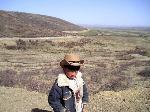

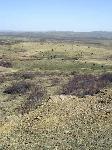
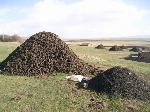

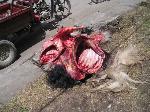
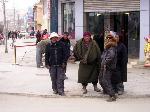
 Copyright © 1998-2025 All rights reserved.
Copyright © 1998-2025 All rights reserved.